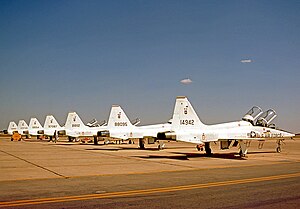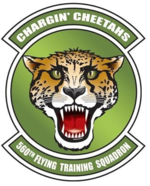560th Flying Training Squadron
 | |
|---|---|
 | |
| Active | 1942–1945; 1947–1949; 1962–1970; 1972–present |
| Country | |
| Branch | |
| Role | Pilot training |
| Part of | Air Education and Training Command |
| Garrison/HQ | Randolph Air Force Base |
| Nickname(s) | Chargin' Cheetahs |
| Engagements | European Theater of Operations |
| Decorations | Distinguished Unit Citation Air Force Outstanding Unit Award |
| Commanders | |
| Current commander | Lt Col Paul Fulkerson |
| Insignia | |
| 560th Flying Training Squadron emblem[b][1] |  |
| 560 Flying Training Sq emblem[c][1] |  |
| 560th Bombardment Squadron emblem[2] |  |
The 560th Flying Training Squadron is part of the 12th Flying Training Wing of the United States Air Force based at Randolph Air Force Base, Texas. It operates the Northrop T-38 Talon.
The squadron was first activated during World War II as the 560th Bombardment Squadron. After training with Boeing B-17 Flying Fortress aircraft in the United States, the unit moved to the European Theater of Operations, where it participated in the strategic bombing campaign against Germany. The squadron was awarded the Distinguished Unit Citation on two occasions for its performance in combat. After V-E Day, the squadron returned to the United States and was inactivated.
The squadron served in the reserve from 1947 to 1949, but apparently was only partially staffed and equipped. It was redesignated the 560th Tactical Fighter Squadron and activated in 1962. It served in the United States until 1970, training pilots for deployment to Southeast Asia, while maintaining readiness for combat operations. It deployed to Korea during the Pueblo Crisis of 1968. The squadron was again activated in its current role as a flying training unit in 1972.
Cite error: There are <ref group=lower-alpha> tags or {{efn}} templates on this page, but the references will not show without a {{reflist|group=lower-alpha}} template or {{notelist}} template (see the help page).
- ^ a b Robertson, Patsy (6 September 2012). "Factsheet 560 Flying Training Squadron (AETC)". Air Force Historical Research Agency. Retrieved 20 September 2018.
- ^ Watkins, pp. 76-77